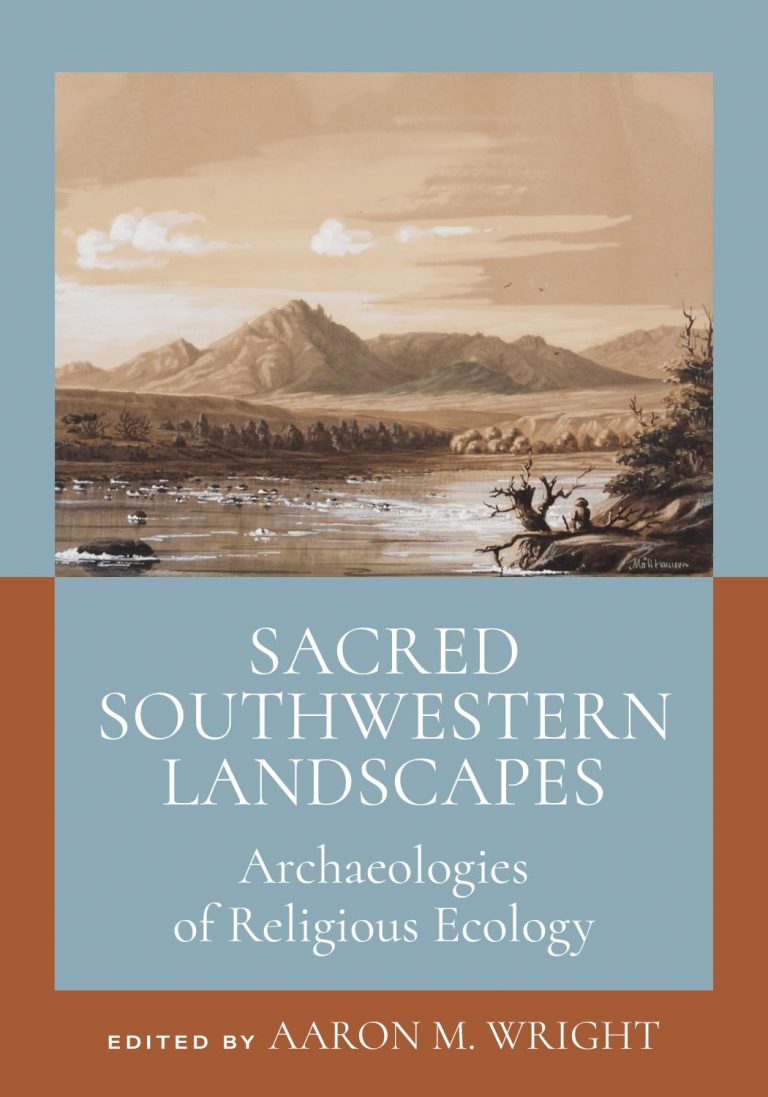Sacred Southwestern Landscapes: Archaeologies of Religious Ecology
Edited by Aaron M. Wright
Through 12 case studies from around the American Southwest, archaeologists, anthropologists, and Indigenous scholars explore communities’ religious relationships with their environments. Divided into the Southern and Northern Southwest, this beautifully illustrated volume presents spatially, culturally, and temporally diverse examples and approaches to understanding religious ecologies of the Southwest, stretching from northern Mexico and the Colorado Plateau to the Mojave Desert and lower Gila River to the eastern plains. Across these diverse landscapes and through time is the persistent message that history is preserved in these places and “religious ecologies serve, in part, to orient humans to the universe.”
While the book’s academic descriptions and archaeological discussions lean heavily toward “hard” science, Wright suggests that it is our humanitarianism more than science that has the potential to save these sacred landscapes from climate change, mining, and development by tapping into the profound wisdom of Indigenous residents and longtime stewards of these lands. This volume presents an excellent and inspiring early foray into this rich topic, giving us a new appreciation for the many layers of cultural meaning held in the land and the dynamic relationship between environmental factors and spiritual beliefs and practices.
The University of Utah Press, 2024; 240 pp.; illus., $80 hardback; $63.95 ebook; uofupress.com

The Indigenous Paleolithic of the Western Hemisphere
By Paulette F. C. Steeves
Selected as a 2022 Choice Outstanding Academic Title, this title bravely delves into the Paleolithic archaeology of the Americas from an Indigenous perspective, providing critical discussion of the Euro-centric history of American archaeology in an attempt to “unpack colonial garbage.” Steeves (Cree-Metis) uses evidence from the archaeological record, genealogy, oral history, linguistics, Paleoenvironmental studies, and mammalian migration patterns, and an examination of Pleistocene sites of North and South America to make a case for a much earlier peopling of the Americas. She describes potential migration routes, environmental changes, and timing, correlating them with oral histories and material culture to provide alternative scenarios to the Clovis-first model and urge researchers and readers to consider Indigenous ways of knowing.
Steeves’ “ceremony of research” seeks to cleanse minds and language of colonial narratives. She awakens us to the use of terms such as “Paleoindian” and “Clovis People” that reduce Indigenous peoples to a monoculture, erasing Indigenous diversity. She describes how pre-Clovis sites have long suffered from rejection, contrary to oral history and material culture evidence. “Erasure of the deep past denies Indigenous people a place in world history that accords them full humanity … separating [their] link to their ancient homelands, heritage, and identity,” she writes.
This essential book fills an important gap left by Western academic educators who generally continue to ignore Indigenous knowledge, culture, and language. It is well-researched, including a detailed map and a useful and extensive appendix regarding select Pleistocene sites of the Western Hemisphere, information that can also be found on her online database of hundreds of North and South American sites dating from 250,000 to 12,000 years ago at tipdba.ca.
University of Nebraska Press, 2021; 326 pp.; illus., $60 hardcover, $30 paperback; nebraskapress.unl.edu
Extracting Stone: The Archaeology of Quarry Landscapes
By Anne S. Dowd and Mary Beth D. Trubitt
A thorough exploration of the archaeology behind stone extraction, Extracting Stone offers readers a fresh perspective on quarry landscapes and their significance in understanding how the extraction of raw materials has shaped civilizations for millennia. This edited volume compiles diverse case studies from various regions, delving into the complex relationship between people, the land, and the resources they relied upon. It focuses on three extraction sites: Flint Mine Hill in New York, along the Hudson River; Spanish Diggings, Arkansas, in the Ouachita Mountains; and Obsidian Cliff within Yellowstone National Park.
The authors weave archaeological, geological, and anthropological perspectives to reveal how stone quarries were not simply economic hubs but also cultural and social centers. Down and Trubitt present stone extraction as a dynamic process, shaped by technology, labor, and local landscapes, making it clear that quarries were integral to the development of communities across different historical periods.
Extracting Stone examines the impact of quarrying on the environment and discusses how quarries have been perceived through the lens of heritage and conservation. It discusses the application of newer, less-invasive technologies as essential tools for studying quarry landscapes and includes examples of how modern technologies are revolutionizing the way archaeologists approach these sites using LiDAR and GIS mapping. By integrating these technologies, the authors argue, modern quarry studies can avoid the significant environmental impact and ethical concerns often associated with traditional excavation methods.
The essays highlight various quarrying methods, from ancient flint mining in Europe to more recent stone extractions in the Southern United States. Through these varied examples, the authors underscore how quarry landscapes are key to understanding not just the material culture of past societies but also their societal structures and economic organization. The book will appeal to scholars, students, and anyone interested in the intersection of human history, natural resources, and the built environment.
Oxbow Books, 2024;168 pp; illus., $34.99 paperback, $20.99 e-book; oxbowbooks.com


Spearthrower Owl: A Teotihuacan Ruler in Maya History
By David Stuart
Organized into five neat chapters with an appendix of key dates, Spearthrower Owl proposes the prominent historical figure of the same name, cited in Early Classic period inscriptions of Tikal, might have been a ruler at Teotihuacan, a vast Mexican archaeological complex northeast of Mexico City. Stuart laid out the argument in a paper nearly 25 years ago, and this book expands upon his theories with never-before-presented evidence. His interest in the figure stretches back to early-career work at Copán.
The book explores the discovery and interpretation of key hieroglyphic texts, which Stuart deftly deciphers, offering a new perspective on Maya political dynamics and the Teotihuacan influence over the region. A detailed analysis of murals, pottery, and inscriptions creates a vivid picture of how Mexican city-state Teotihuacan left its mark on Maya culture. It closely examines the Entrada of Jan. 16, 378 through the lens of newer discoveries and historical interpretations. This well-researched, nuanced book brings together archaeology, epigraphy, and iconography to shed light on this important figure in the dynastic politics of the Maya Lowlands, who ruled from A.D. 374 to 439.
Stuart also provides a compelling narrative of how Spearthrower Owl’s legacy may have shaped subsequent Maya rulers and the wider cultural landscape. He argues that the interactions between these two ancient civilizations were not merely sporadic, but deeply influential, changing the trajectory of Maya political and religious practices. Overall, this volume is an insightful contribution to Mesoamerican studies, blending rigorous scholarship with an engaging storytelling accessible to both scholars and general readers interested in the ancient Americas.
Harvard University Press, 2024; 154 pp; illus, $69.95 paperback; hup.harvard.edu





